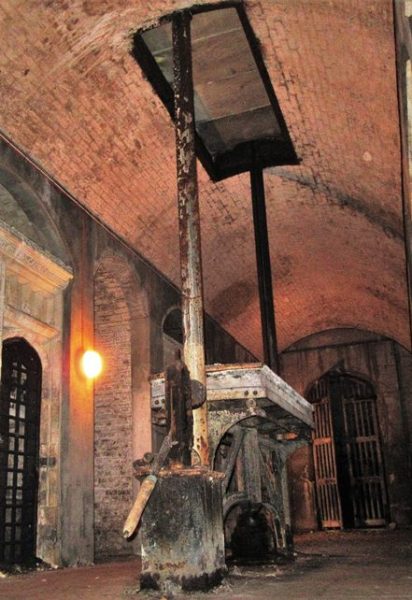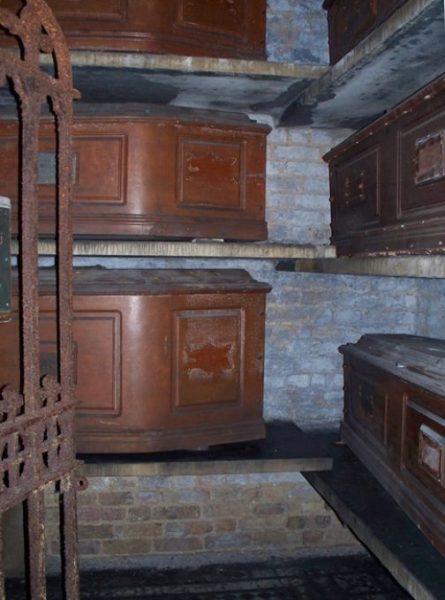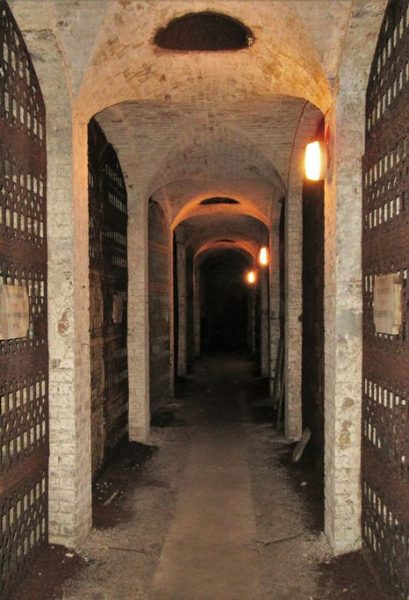
The catacombs were part of Sir William Tite’s original design for the Cemetery Chapels. Both Chapels were provided with catacombs. Together they could accommodate around 3,500 coffins. They were the most expensive place to be buried in the cemetery. They are uniquely designed in the Tudor Gothic style reflecting Tite’s architecture of the two chapels, lodge and entrance arch.
The catacombs below the site of the Nonconformist Chapel (now the Crematorium) are no longer accessible as the cremation furnace is located there.
The Grade II listed catacombs survive beneath the site of the Anglican Chapel with an estimated 2,500 coffins and a hydraulic coffin lift. This was used to move coffins from the chapel above down to the catacombs. Sir William Tite is among those buried in these catacombs. They comprise 6 corridors leading off the central aisle. This lay directly beneath the Anglican Chapel. Each of the 6 corridors has 14 vaults, containing space for about 3,000 coffins. Within each vault, most coffins were stacked on stone shelves or iron bars, although a few were placed on wooden trestles.
The central aisle includes the hydraulic coffin lift. This includes a lever which was used to pump the platform up to the chapel where the coffin rested during the funeral service. At the end, a hydraulic valve was released allowing the coffin to sink slowly into the catacombs. The hydraulic system was patented by Joseph Bramah.
The central aisle also includes a narrow staircase that led up to the Anglican Chapel. After the Chapel was demolished, the stairs remained but were sealed off at ground level.
The catacombs contain many memorial tablets which used to adorn the walls of the Chapel and colonnades. They commemorate people buried in the catacombs and elsewhere in the cemetery. Also stored here are a few carved angels and similar decorations saved when the Chapel was demolished by the South Metropolitan Cemetery Company in 1960.
One corridor contains coffins placed so they could be removed easily, should the need arise – such as the family leaving London. For various reasons these coffins were never moved and remain untouched in their original positions.
All coffins in the catacombs had to be fully sealed. Usually the deceased was laid first in a coffin shell made of Elm. This was then wrapped and sealed in sheet lead which was then placed in an ornate coffin (often of mahogany or oak) which formed the outer (or visible) coffin. Some were also wrapped in rich velvet and decorated with brass or gilt nails which secured the velvet to the outer shell.
In the central aisle families could buy an entire vault to which they would be issued their own keys. They could also have the family name inscribed into the stonework above the gates. Some also display the family coat of arms. More usually, families purchased a single shelf or half shelf, each sealed behind iron grilles or stonework.
All the coffins are identifiable by the name plates attached to each coffin. In addition each vault and space is individually numbered and labelled, so the names of every person buried in the c can be identified. There is a complete list of these held in the cemetery office, and details can also be found in the Lambeth Archives at Brixton Hill.
Unfortunately the catacombs are now closed, but Lambeth Council is raising money so they can be made accessible once more.
A 3D model of the catacombs has been created and can be seen here.
Photographs courtesy of Robert Stephenson



